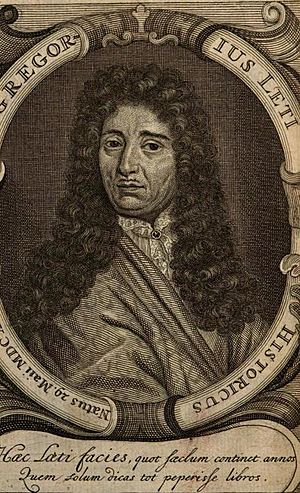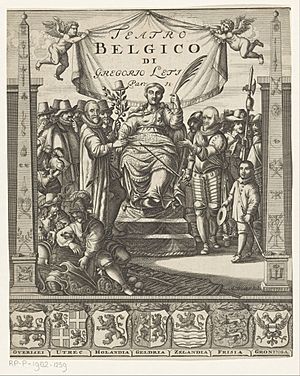Gregorio Leti facts for kids
Gregorio Leti (born May 29, 1630 – died June 9, 1701) was an Italian historian and writer. He was from Milan, Italy. He sometimes used other names like Abbe Gualdi. Leti was famous for his books about the Catholic Church, especially about the Popes. Many of his books were put on a special list called the Index Librorum Prohibitorum. This meant the Catholic Church did not want people to read them.
Contents
Gregorio Leti's Early Life
Gregorio Leti was born in Milan on May 29, 1630. His parents were Girolamo Leti and Isabella Lampugnano. His grandfather, Marco, worked for a important church leader before becoming a judge. Gregorio's father, Girolamo, was a soldier. In 1628, he was sent to Milan to help the Spanish army. There, he met and married Isabella. Gregorio was their son.
In 1632, Gregorio moved with his parents to Amantea. His father became a military commander there. When his father died in 1639, Gregorio's mother sent him to a Jesuit school. He stayed there until 1644. Then, his uncle Agostino invited him to Rome.
Life in Rome and Milan
In Rome, his uncle wanted Gregorio to become a lawyer or a priest. But Gregorio did not want to. He went back to his mother in Milan. He stayed with her until she died in 1646.
At 16, Gregorio was an orphan. He had to go back to his uncle, who was now a church leader in Orvieto. Gregorio found his uncle's rules very strict. He stayed with his uncle until 1654. During these years, he moved to Naples in 1647, Milan in 1650, and back to Rome in 1652. In Rome, he met people from a group called the Academy of Humorists.
In 1654, his uncle gave up trying to make Gregorio choose a career. He gave Gregorio his inheritance, which meant Gregorio was free to travel. In 1655, Gregorio had money problems. He went back to his uncle, who was now a Bishop. Gregorio wanted to marry a woman named Antonia Ferretti, but she said no. Soon after, he left his uncle's home for good.
Leti's Later Career and Travels
Even though Gregorio Leti went to a Jesuit school, he later became a Protestant. He lived in the court of King Louis XIV of France for a while. In 1680, he moved to England and worked for King Charles II of England. The King asked him to write a history book about England.
Leti had access to many books in England. He could use the large library of the Earl of Anglesey, which had over 5,000 books. He also used the library of Bishop Gilbert Burnet. Leti wrote the first real life story of Elizabeth I of England. This book included some exciting, romantic details about her younger years and her mother, Anne Boleyn. He might have found some of these details in the English libraries he used. Leti was also chosen to be a member of the Royal Society, a famous group for scientists and thinkers.
Leaving England and Life in Amsterdam
In 1683, Leti published a book called Il Teatro Britannico. This book had many stories that upset King Charles II. Because of this, Leti had to leave England. He went to Amsterdam, a city in the Netherlands. In 1685, he became the official historian for the city of Amsterdam. He lived there until he died in 1701.
Leti's book about Pope Sixtus V was translated into many languages. It includes a story that is similar to the famous "pound of flesh" story from William Shakespeare's play The Merchant of Venice. Some historians have said that Leti's books were not always perfectly accurate. For example, the Catholic Encyclopedia said his works were "not exact." Other historians also mentioned that he was "inaccurate." Even so, his books were very popular.
Gregorio Leti's daughter married a famous scholar and theologian named Jean Leclerc.
Gregorio Leti's Books
Gregorio Leti wrote many books during his life. Here are some of his well-known works:
- 1666. Histoire de Donna Olimpia Maldachini.
- 1667. Il Nipotismo di Roma, o vero relatione delle ragioni che muovono i Pontefici all'aggrandimento de' Nipoti (This book was about how Popes often helped their relatives become powerful).
- 1668. Il Cardinalissimo di Santa Chiesa.
- 1671. Le visioni politiche sopra gli interessi più reconditi di tutti i principi e repubbliche della Cristianità (This book explored political ideas of different leaders and countries).
- 1672. L'Europa Gelosa (Jealous Europe).
- 1682. La Vita della Regina Elizabetta (The Life of Queen Elizabeth).
- 1684. Il Teatro Britannico (The British Theater).
- 1685. L'histoire de la vie du Pape Sixte Cinquième (The History of the Life of Pope Sixtus the Fifth).
- 1685. Il ceremoniale historico e politico, opera utilissima a tutti gli Ambasciatori (This book was about historical and political ceremonies, useful for ambassadors).
- 1686. Historia Genevrena (History of Geneva).
- 1690. Teatro Belgico, o vero Ritratti Historici, Chronologici, Politici, e Geografici (This book contained historical, time-based, political, and geographical descriptions of Belgium).
- 1693. Historia overo Vita di Elisabetta, Regina d'Inghilterra (Another book about Queen Elizabeth of England).
- 1697. Critique historique, politique, morale, économique, & comique sur les lotteries (This book was a historical, political, moral, economic, and funny critique of lotteries).





